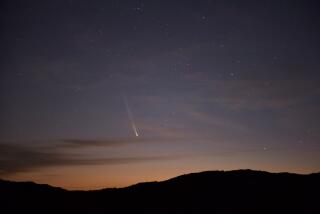Sky watchers gather to view rare transit of Venus
- Share via
Across Southern California, sky watchers assembled Tuesday afternoon for a chance to view the last-in-a-lifetime transit of Venus.
They donned protective glasses and peered into filtered telescopes to watch the planet as it crossed in front of the sun for the last time in more than 100 years. They spoke of watching a tiny black dot creeping ever so slowly across the solar disk with a combination of reverence and resignation.
“It’s like watching grass grow,” said 93-year-old Don Nicholson, describing Venus’ 6-hour, 40-minute progression, most of which was visible locally before sunset. “But if you were told that grass only grows every 100 years, you’d probably want to watch it.”
A transit of Venus occurs when the planet’s orbit takes it directly though the line of sight between Earth and the sun. Transits of Venus usually occur in pairs, several years apart, roughly each century. The last was in 2004. The next set will be in 2117 and 2125.
Over the centuries, scientists have tracked the rare events with keen interest. During the 1761 and 1769 transits, they used measurements collected by a number of illustrious transit-chasers, including Capt. James Cook, to calculate the distance between the Earth and the sun. Tuesday’s transit was the seventh to be observed — and the eighth overall — since Galileo developed his telescope for looking at the sky.
Nearly 150 amateur astronomers gathered to watch at Mt. Wilson, including Nicholson, who has been coming there to view the sky since he was a child. His father, S.B. Nicholson, an astrophysicist working at the observatory, discovered four of Jupiter’s moons.
At Caltech, about 1,000 people were expected to watch the event. About 3:10 p.m., three minutes after the transit’s start, the edge of Venus began to come into view — a tiny indentation in the sun’s glow. In celebration, Caltech’s Pep Band struck up a rousing rendition of John Philip Sousa’s 1883 “Transit of Venus March,” which marked the transit of 1882.
A short walk away, several hundred people, including dozens of children, lined up on the athletic field behind the Cahill Center for Astronomy and Astrophysics. Orange T-shirt-wearing members of the Caltech Astronomy Outreach group, a graduate student organization, handed out protective glasses and manned seven telescopes.
Rhonda Hillbery and Kathleen Hamilton, who work in development for the university, debated whether they could see Venus. Hillbery could; Hamilton wasn’t so sure.
“I really want to see it,” she fretted, “but I’m not sure I am.”
Five-year-old Margaret Adams-Mao of Santa Monica got a sharper view through one of the telescopes equipped with a solar filter. “I saw a yellowish whitish big circle and a black dot on top,” she reported.
Farther south in Seal Beach, about a dozen senior citizens gathered to watch at Leisure World. As the speck of Venus crept over the sun, some quipped that it could just be spots in their eyes.
“It wasn’t Venus, it was a floater,” Donna Terrano, 61, joked, describing the dots that sometimes pop up in her vision.
But as she continued watching, Terrano marveled that the transit put things in perspective: “It gives us a sense of wonder, a sense of glory in the heavens.”
Times staff writer Rick Rojas contributed to this report.








